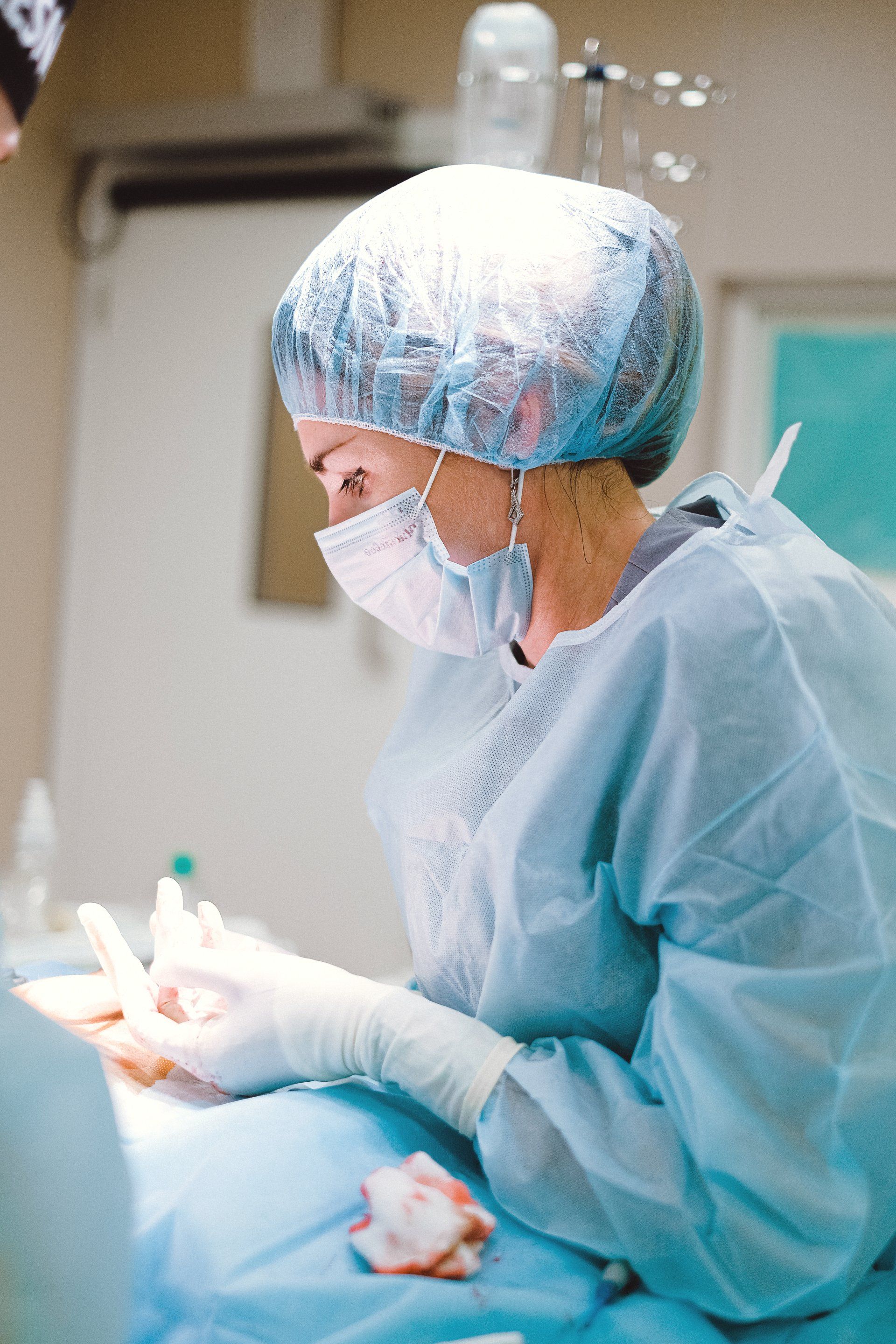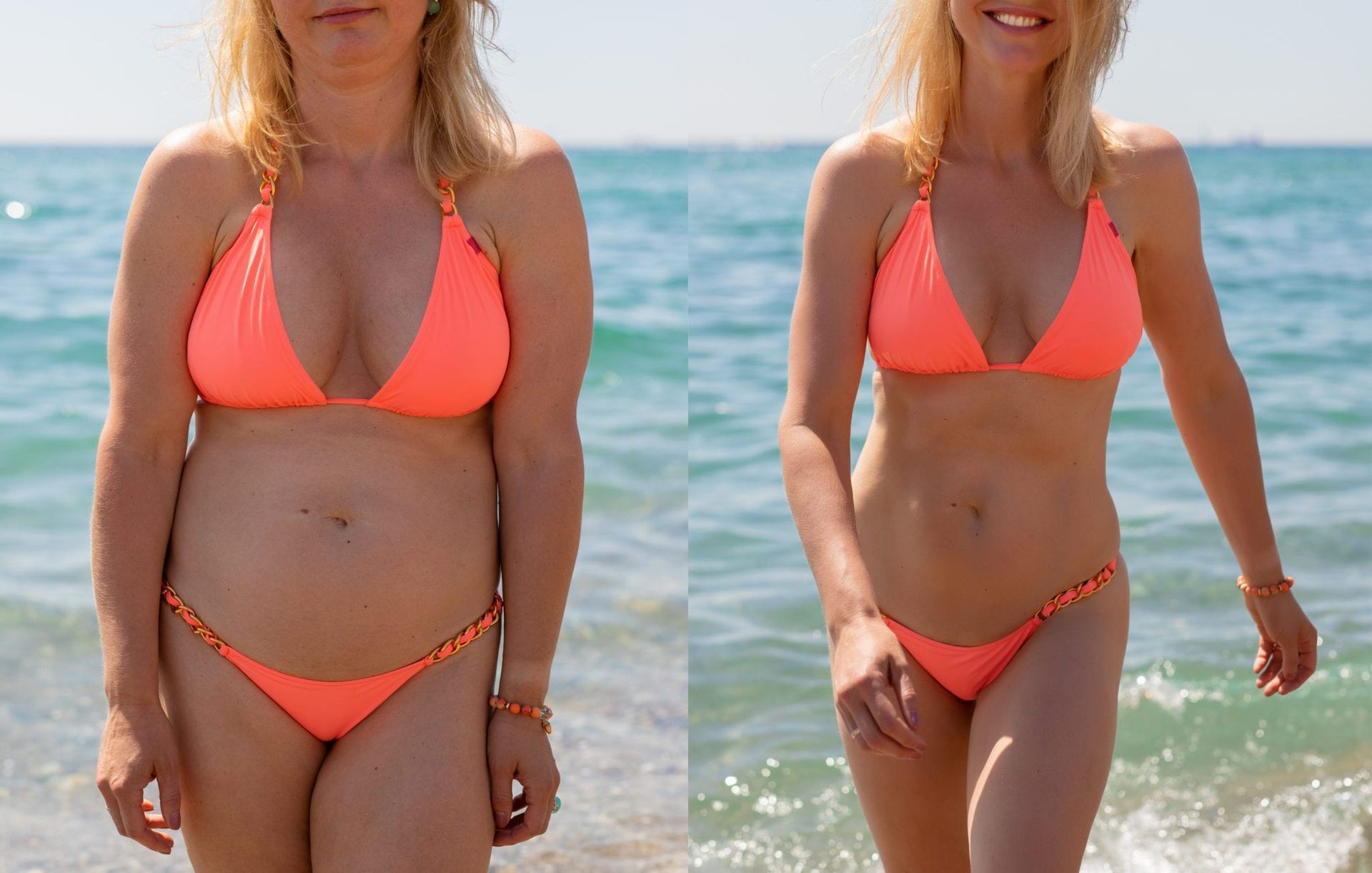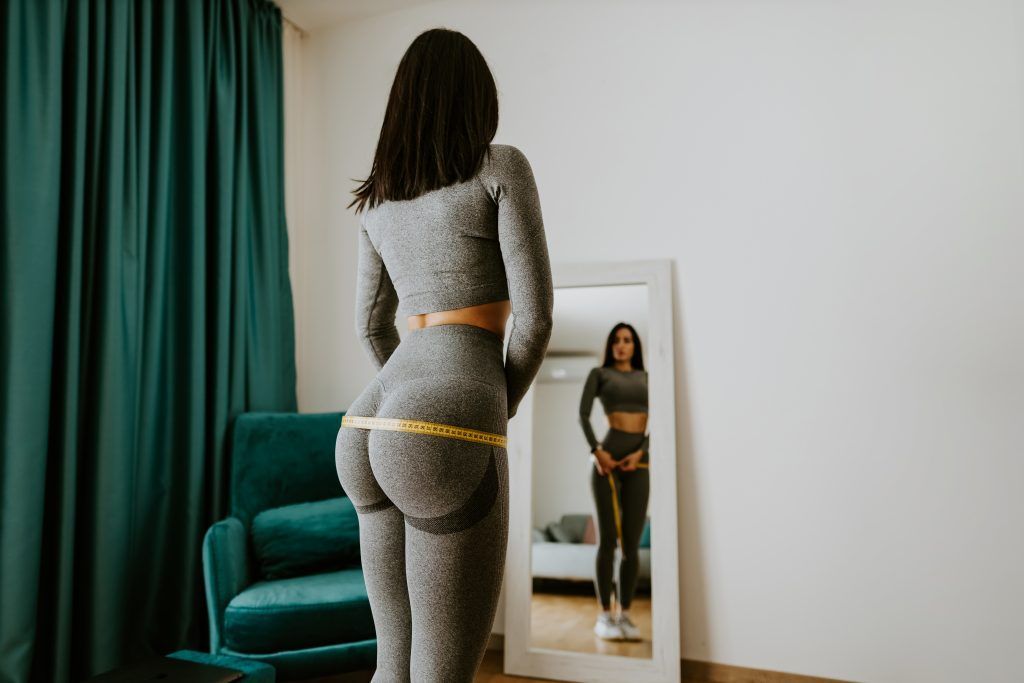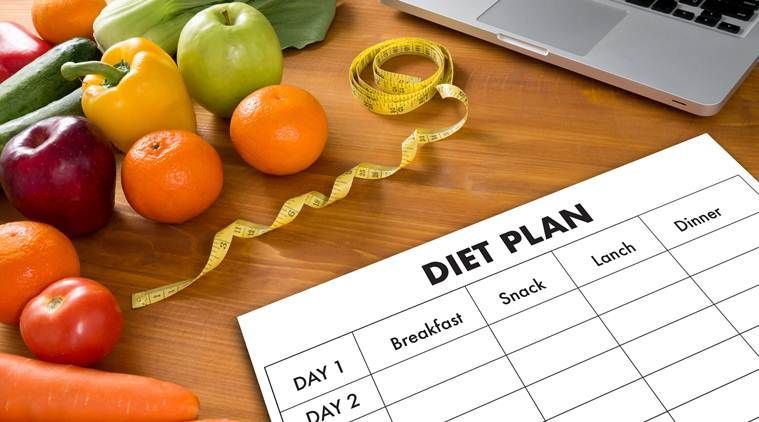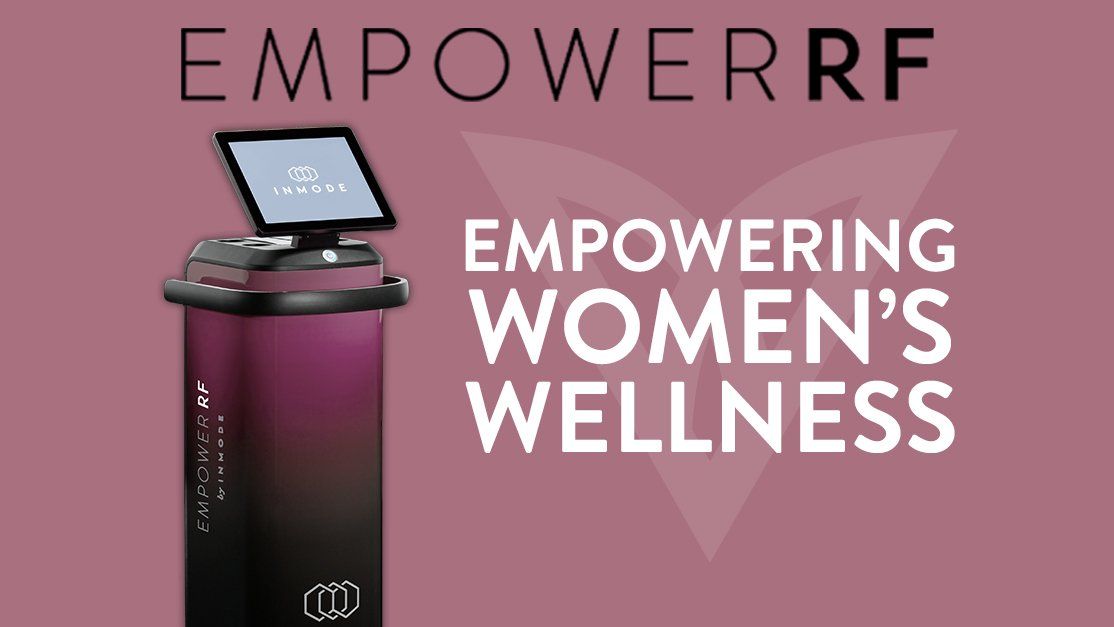Liposuction: It Doesn't Suck
Liposuction - It Doesn't Suck!

Nipped and Toxxed Episode III
Ashley: All right. Welcome to episode three, liposuction. It doesn't suck, starring Ashley Robey and Katie Reichart
Katie: I am a CPCP and professional makeup artist. We are talking about liposuction on Nipped and Toxxed.
Ashley: I'm Dr. Ashley Robey, a quadruple board certified plastic surgeon. So plastic surgery, facial plastic surgery, otolaryngology and anti-aging medicine. So, Katie, liposuction, like we said, it doesn't suck. What are your thoughts?
Katie: I've actually never had liposuction, but I am super intrigued.
Ashley: Yeah. It's a great way to do body contouring. First and foremost, it's about establishing what can this do and what can it not do? And what it is not good at doing is helping people lose weight. So it's definitely not a weight loss procedure. And I feel like that's a common misunderstanding about what it could potentially accomplish, but it's for body contouring. So someone that is already near or at their ideal weight, but despite that just thinking, okay, I have this resistant spot or two that is still not the shape or contour I want it to be.
Katie: So what BMI would somebody need to be if they're looking for their ideal body weight? What BMI are you going to say? Okay, I'll do some liposuction on you.
Ashley: Sure. So BMI is body mass index, which weight divided by your height in meters squared. So it provides you a number. If that number for you is in the 18 and a half to 25 range, that's considered to be an ideal BMI. If your BMI is 25 to 30, that's considered to be overweight and anything over 30 is in the obese category and there are different levels of obesity. Obviously the higher, the number of the more obese you are.
So obviously someone comes in and they're on the high end of this scale. You know, help them with some medical weight loss instead of doing the lipo route.
So that is a service that I offer in my office. And, in part, because earlier on in my practice, I saw a lot of patients that were wanting to make those changes for their body, but they weren't really great liposuction candidates.
And I didn't feel right just saying, okay, well, go lose weight. It's going to be easy. See you later because, you know, they would never come back. So, I had the ability to help patients with regards to medical assisted weight loss. So we do do that in my office with my nurse practitioner, but yeah, like I said, ideally, you're in that ideal BMI range.
I do patients certainly that are overweight. My general cutoff, as far as body contouring is I like patients to be under a BMI of 32. That does technically account for some patients who are in the obese category, but over that losing weight first will definitely be preferable and safer.
Katie: the other thing I think of when I think of this is BBLs are really popular and so...
Ashley: Brazilian butt lift?
Katie: Yes! Brazilian butt lift, BBL. You know, if you want a big butt, but a small waist, you know, I want to be taking it out of the middle and then maybe you should actually describe how they do a BBL, because I think a lot of people don't understand.
Ashley: So BBL or a Brazilian butt lift is also called fat transfer to the buttocks. What you would do is liposuction areas of relative excess, and you're right, classically it's the abdomen and the flanks, or love handles or whatever other area that seems like a good donor site.
And then you inject it into the buttocks. You can only inject so much volume to a specific space at a time. You reach a point of diminishing returns. And so that's just going to be a function of how big your butt is or how flexible or mobile your soft tissue envelope is in the beginning. If you have very muscular buttocks with no loose skin and no fat, it's going to be really hard to fill that up because there's not much space to fill up, but if you have deflated, saggy buttocks with already some fat, that will be more amenable to adding fat to.
So for me, and also this is also recommended by the American Society of Plastic Surgeons, transferring fat to the buttocks should be only performed in the subcutaneous layer. There are some surgeons who will inject fat in the muscular layer, and granted with that extra space, so to speak, you can get more fat into the buttocks, but it's way more risky. If some of that fat goes into your gluteal veins, that could be life ending.
Katie: So, one of the most dangerous procedures.
Ashley: If you're doing it wrong. Sure. So you have to find someone who knows how to do it appropriately. Anything that's done in an unsafe fashion is dangerous. So you have to find someone who knows the correct way. So there's lots of different little technique differences that you would use to make that safe.
Katie: So where else can I inject fat, that you had already extracted from another spot?
Ashley: So we want to get all on about fat transfer?
Katie: So if you're got to take it out of one spot and put it into another…
Ashley: I tell patients that if you're thinking about fat transfer, and you're already doing liposuction, it makes sense. You can't do a fat transfer without doing liposuction. So, if you have an area of excess, and you're liposuctioning that, and you're thinking, Hey, I wouldn't mind having more volume in this area. Like, we're either going to throw the fat away or you're going to use it. The most common areas that I use fat are the face, the breasts and the buttocks. Not specifically in that order, but all three are very popular. You can put it in all kinds of places; sometimes I'll do more atypical areas, like filling in little divots or dents or a previous liposuction contour irregularity.
Katie: Rather than getting a breast implant, like just taking some of your own fat.
Ashley: It is appealing because it doesn't have the maintenance associated with breast implants. The downside of doing a fat transfer to the breast is that one about 50 to 70% of the fat injected will survive and two, there's a maximum amount of fat that you could fit into a specific space.
I would say like maybe a single cup size bump and that's it. So if you're looking to go up one and a half, two cup sizes, that would not be achievable with a single surgery. Not that you can't have more than one...
Katie: We have a friend that has asymmetrical breasts . One side is significantly smaller. This would have been probably, or would be a good option for her if she wanted to correct that, you know, and keep it natural.
Ashley: The truth is that I think most patients have some degree of asymmetry. I've definitely done a handful of patients that have substantial degrees of asymmetry where one side is an A/B cup, another one's like a C plus where we're just adding fat to the small breasts because it's just so far behind the big one that they're just, they're just trying to play catch up.
Katie: So if I'm coming in for liposuction, am I doing it in your office or are we going to a surgery center or does it depend?
Ashley: The vast majority of patients are done at an outpatient surgery center. I occasionally will do in office liposuction but, it's not very fun for me. And I don't think it's really fun for the patient either.
You have to get really numbed up. Plus even once you're numb, I think you can kind of still feel some of the, not pain, but you kind of feel someone like tugging and kind of pushing your tissue around.
Katie: a rod, right?
Ashley: Yeah. Canula,
Katie: that's the word. You know, hollow. Right?
Ashley: The most popular cannula size that I use for body contouring is a four millimeter diameter cannula to the internal diameter. So it's not huge, but still, you have to be really numb. So it's doable for like one area.
But the vast majority of people for whom I'm performing liposuction, aren't doing a single area, liposuction. They're coming in like, oh, can you do my upper abdomen and my lower abdomen and my flanks and this and that.
Katie: So you want you to be in an environment where you have a anesthesia?
Ashley: How long would the procedure take? Let's just say I just did your upper and lower abdomen...
Katie: Right.
Ashley: I feel like that's easier. It's actually quicker too. Yeah.
Katie: So, are they asleep?
Ashley: Yes.
Katie: Okay. And how long does it take, like if you're going to do someone's abdomen? I know it's relative because I wasn't sure, but like how long would that kind of procedure last?
Ashley: Like an hour. Most people would do the upper and lower abdomen and the flanks, which would be an hour and a half.
And some people that have really full love handles, or flanks, we'll flip them over so I can see that whole space completely. And then that takes like two hours.
Katie: Now do you liposuction the back?
Ashley: Yeah.. So the flanks are kind of like the lower back love handle area. So , I have like upper back, which is, for women, the part above your bra strap.
Katie: Right.
Ashley: And then you have your mid back, which is like bra strap down to the flank area. And some people, if you have a lot of fullness there you'll have that crease and then that space below it is the flanks. So any loose skin above that crease in the back, like in order to get rid of that, you have to pull everything above it up and everything below it down, because it's pretty adherent.
Katie: Are you ever doing that by itself or the flank area and all of that, are you doing this in combination with the tummy tuck?
Ashley: I would say of the people that get a tummy tuck, 95% are getting flank lipo, in my practice.
Katie: What about other parts? You know, you also then lipo stomach area?
Ashley: When you're doing a tummy tuck, you have to be careful about overly aggressively doing liposuction in that area that you just lifted up, called an abdominal flap, because you can really start disrupting the blood supply.
Katie: But you know, you don't want to be going to somebody that's on the internet, you see a lot of this 360 lipo and things like that and whole body lipo. So what are people talking about when they say 360 lipo?
Ashley: So there's a lot of marketing terms that I think are utilized just to appeal to different patients. So the 360 lipo is basically doing liposuction all the way around something like your body. So going all the way around your midsection, going all the way around your leg, going all the way around your arm. But classically it's talking about the torso because that's where most people are getting it.
Katie: So what about, I saw one of the Housewives said that she went before one of the reunions and got full body lipo. So what does that mean if she got full body lipo?
Ashley: I think it's a kind of vague terminology, but it sounds like she's had multiple areas liposuctioned. As a rule of thumb. If you're wanting to do outpatient liposuction, the maximum amount of lipoaspirate that's recommended is five liters. And if you do more than that, then it's recommended that you stay overnight. But for the most part, I try to limit my lipoaspirate to five liters.
Katie: So if I get five liters taken out or whatever, I get. Am I going to go home that day and what am I going to feel like? Can I move around?
Ashley: Liposuction in and of itself isn't particularly painful. And I think that's one of the nice things about it. It's a minimally invasive procedure, meaning that you have small one centimeter or approximately a thumbnail width incisions. Ideally if your surgeon is doing things correctly, they're trying to hide them. Although that being said, I've certainly seen incisions right in the middle of structures and I'm thinking, why would you ever put that there? Yeah, they're small, they're hidden. I do use a lot of long acting numbing medication , Exparel, which is a numbing medication that lasts about 72 hours.
So for my patients that just get liposuction, it would not be uncommon for them to say well, I was sore, but not even enough that I needed like a Tylenol.
Katie: Now are they going to look bruised?
Ashley: It depends on the person. Some people are easy bruisers and some people not
Katie: Someone that just doesn't bruise goes and gets liposuction. For some reason, I'm thinking like you're going to be bruised.
Ashley: You should go into it with a mindset, like you're going to have bruises. And then, if you don't, you're like, yeah, yeah, I don't have bruises. But if you do it, you're like, oh, I thought so.
Katie: Are you to continue to have fat loss in that are?
Ashley: After liposuction?
Katie: Settling period? Cause you've just created 10 of these?
Ashley: Your initial volume change will be masked by swelling. Right? It'll seem fuller in the first handful of days and actually longer than that because of post-operative swelling, but the actual amount of fat that's there won't specifically go down.
Katie: So how long is the post-operative swelling?
Ashley: It can vary from person to person. I tell patients, depending upon the area, it can be six, nine months before all of it is totally resolved. If someone was interested in revising an area of liposuction, that it's helpful, that you've waited a period of approximately that duration until all the swelling has resolved so that you're not working on a, on a potentially moving target
Right. And if you have an event that you're like, man, I'm going to look really good. Like you need to back that out by nine months.
I think you'll notice some things right away. Right. You're not going to suction out multiple liters and be like, it looks the same.
Katie: Well it’ll definitely look different, but you want to be like completely healed and feeling fine.
Ashley: I would say a minimum of six weeks before an event would be ideal.
Katie: Now say I have like dimples? Will it get rid of dimples?
Ashley: Liposuction can help. So you can get cellulite or kind of dimple changes because of vertical septations or pieces of connective tissue between your skin and the deeper layers of tissue. So they are little tethers. Liposuction can help break those up. And there are instances, especially if I find one area particularly problematic, then I'll break out what's called a pickle fork, which kind of looks like a V-shaped fork that has a cutting part. And you can find those little things and then just cut them
Katie: And just snip them, and you can improve irregularities just while you're in that procedure.
Ashley: For sure.
Katie: Amazing.
Ashley: But, you're not going to get rid of all of those things, but you can soften them for sure.
Katie: This is what I like about the fact that you're a woman and that you notice what a woman's gonna want, like the aesthetic part of things.
Ashley: I'm assuming male plastic surgeons also feel the same, but men and women think differently.
Katie: I just think that, you know, from a woman's perspective, I liked that you're thinking of those things and doing those, not that other people would have done. That's really cool.
Ashley: Thanks.
Katie: So as far as liposuction goes you know, obviously there's visceral fat and there's subcutaneous fat. When you have somebody come in that you can tell, like, hey, you're not a good candidate
Ashley: And unfortunately, I think for men, specifically, the visceral fat component tends to be even more of a problem. By visceral fat, I mean, the fat that's in between and around your intestines, the fat that's not going to be addressed or improved with liposuction because we're not going to be getting into that space. You're not going to liposuction, your intestines. The extra abdominal fat is the part that you can get with a liposuction.
And what I'll tell patients to do is look in the mirror and look at your abdomen and then flex your core, really tight, like you're sucking in. Right. And the part that's left, the part that you kind of still grab and pinch that's on the outside, that's the extra abdominal fat. So if that part is substantial, that's the part we can make some impact on with liposuction. If when you do that, you're like, well no longer do I have a problem, then you've just basically have compressed all of your visceral fat. And that really is only addressed via diet and exercise and not liposuction.
Katie: So what does liposuction cost? Talk about traditional liposuction?
Ashley: So there are different ways to do liposuction. People will do things like traditional, suction assisted lipoplasty, which just means you have a canula it's hooked to a vacuum and you're sucking.
There are other ways to do it: laser liposuction and ultrasonic or Vaser liposuction and then power assisted liposuction. Really the biggest difference between traditional and the different kinds of modalities is from the user end point and by user, I mean, your surgeon. If you have some laser or power assisted or whatever, it does tend to help make it a little bit easier to suck out the fat. You're not just relying on, so to speak elbow grease, you're using some other modalities to break up some of that connective tissue. So that's helpful, but as far as results go, not really different.
Katie: So what about their skin?
Ashley: So I do a thing called Body Tite and that uses radio frequency, energy to heat up the overlying tissue and then it causes a contraction. So at about six months, patients are averaging approximately a 25% contraction. And then at a year it's closer to 40%. Whenever you remove volume or suctioning out fat, that is, you have to always think about what are the impacts for the overlying skin. So in general, it tends to make whatever bit of laxity that's there worse. If you're suctioning out a substantial amount of fat and there's already hints of skin laxity, It would be helpful if your a surgeon had a plan to address that.
So for my patients, if it's not hugely problematic, but it's a little bit concerning, we'll do Body Tite, which allows us to utilize the same minimally invasive incisions that I use for liposuction, but that it will heat up the tissues and cause some contraction. And again, it's a little bit of a delayed fashion.
Katie: So there's no such thing with skin tite?
Ashley: When you use Body Tite, you're always using liposuction with it. It's part of the treatment.
Katie: Is that different? You also do liposuction or you always do Body Tite?
Ashley: So you can do liposuction alone and you can do body tite with liposuction, but almost never would you do Body Tite without liposuction. If you don't have a lot of fat, but you have some loose skin, you could do Body Tite, but you'd probably do what I would describe as a cleanup amount of liposuction, meaning maybe you only get a handful of CCS, but you're going to still go in there and kind of clean up whatever tissue that the Body Tite has rendered non-viable.
Katie: So is there a price difference? Is Body tite more expensive?
Ashley: It's just like you're doing a whole other thing, so it takes longer. So time is money.
Katie: So if someone comes in and says, and let's say they're an average BMI, they want their stomach done. Like what's a range on what that costs?
Ashley: Just liposuction?
Katie: Yeah.
Ashley: Maybe like 7,000, 8,000, something like that. You know how bad I am about I am with giving you numbers.
Katie: Give me a range.
Ashley: Something like that. And then as you add more and more.. . It does get more expensive, but it's a function of time and how long it takes to do it.
People that are bigger and they have a lot more fat -it takes a little bit longer to do it. So it can be a tad bit more expensive for those patients.
Katie: So, now in regards to high Def lipo, someone is pretty fit, but they want to create the look of abs or they want to have a more defined abdomen. You know, what is the range on that? And what is that procedure like?
Ashley: Abdominal etching is a way to create almost like a six-pack abdomen. I think in some cases, it does look really good, but the patient also has to consider their BMI and their body habits. In other words, you're not going to have someone who's obese that is kind of plump everywhere else, but just has like a ripped abdomen. Like it just, some things don't go together. And as a plastic surgeon, I'm always thinking about what makes sense. What's harmonious, you know, you want all of these body parts to fit together.
And so in my mind, creating some ripped abdomen when you have rolls of fat elsewhere. Like I just, I don't buy into it. So I wouldn't do it in most cases
Katie: As, you know, some people's abs look different.
Ashley: You can get more aggressive with some techniques. You can try to make it more defined or less defined. Create just some vertical lines versus trying to create the whole eight-pack..
Katie: Do we know people who have had this done?
Ashley: Yeah.
Katie: Do I know this one? I thought it looked really great on the first one I had it done. I thought it was really amazing. So is the cost for that going to be around the same?
Ashley: no. It cut costs a little bit more because it takes more time.
Katie: That's more like artistic.
Ashley: For my practice, anything that takes more time, you're doing more stuff comes at a price.
Katie: Can someone come in and say, this is the pattern that I want, are you going to be like hmm, no
Ashley: If their pattern is a good pattern.
Katie: If it makes for their body .A lot of people are going to show photos, right?
Ashley: Yeah. I mean, I'm not going to create like a Batman nine pack or whatever, right. Just because someone wants that.
Katie: No, no, no. But, if someone comes in and says, you know, maybe they don't want a nine pack that definition of little like valleys, because you see these celebrities out there aren't this fit naturally. I mean, some of them are getting some work done. They might not look like they have an eight-pack, but they might just look like they've got two toned areas, you know, there's different ways.
Ashley: Some people will just define that transition between the two rectus muscles in the midline.
Some people will do that lateral border of the rectus muscles, and some people will try to do all those various conscriptions in between to get six pack eight pack - whatever it is..
Katie: So, if I was going to get lipo , what would I do to prepare, to make sure that like I have optimal healing? What would be the best?
Ashley: Being at your ideal weight. Being healthy enough to have the procedure .And having appropriate expectations.
Katie: So do you do a checkup on somebody before they come in? say like, Hey, you're going to be good. Or say they're in their consultation, do you like examine them or do they need to give you like a physical?
Ashley: It depends on their history. Some people, if they have zero health problems, don't need to go get clearance from their primary care doctor or a cardiac clearance. So it's very patient dependent -depends on your history and risk factors and those kinds of things.
Katie: So, basically just healthy and at a good BMI?. I don't need to cut out alcohol or…?
Ashley: I definitely wouldn't drink right before surgery. It's bad. And I wouldn't drink the night before. Not even when you can't be like a heavy drinker that would not be helpful.
Katie: Inflammation coming to play?
Ashley: Alcohol is inflammatory.
Katie: I feel like I'd have inflammation. So like, should I, you know, do an anti-inflammatory diet, is that going to help me have better results?
Ashley: Probably just help you be healthier. And I think those are two problems that are related.
Katie: Well, shouldn't you follow a specific diet, obviously you don't want to gain weight after you have lipo.
Ashley: So after liposuction, I have patients avoid strenuous activity or exercise for about two weeks. And then I also fit them into compression garments that they're wearing for about three to six weeks. Sometimes the garment that seems to fit best right away after surgery after a week or so it can become loose. So it wouldn't be uncommon for someone to need a secondary garment.
Katie: So when they buy the garments from you or do you just direct them in the right way?
Ashley: I usually have them buy them from me because I buy so many and I get a bulk discount, but that being said, they can buy from whomever they want, but I don't make money off garments. I just help facilitate patients getting the appropriate garments.
Katie: So the garment is contracting?
Ashley: Yeah, it's called a compression garment. It helps with the swelling and it also helps try to minimize fluid collection seromas, yeah.
Katie: So what's the ideal time to have this done? Winter?
Ashley: I don't think that there's an ideal time. It's whenever you feel like you have some downtime in your life to take a break. And I know sometimes that can be hard and sometimes it just has to be like, you're just going for it and just setting aside some time.
Katie: So can you lift heavy things?
Ashley: After liposuction? Yeah. You don't have any lifting restrictions after liposuction. That's not the case with things like tummy tucks and breast augs, but liposuction, Yeah, you can lift.
Katie: You say no strenuous activity, what exactly does that mean?
Ashley: Things that get your heart rate and blood pressure up. So like, don't go for a run. Don't do what's going to get you breathing faster or get your heart rate up.
Katie: So no like cleaning the house?
Ashley: Yeah. That's like ever, you can never clean the house again, or do laundry, make dinner.
Katie: As far as skin retraction goes after lipo... If you're a healthy person, is your skin going to retract on its own? Or do you need to do other procedures? Like, do we need to combine this with like Morpheus 8? Or Body Tite?
Ashley: That all has to be part of a comprehensive evaluation. So that's always something I talk about during any consultation. Like I was saying earlier, you have to address not only the excess fat, but the implications for the overlying skin. Your options are one, do nothing, right? You could just like, okay, well maybe it's already loose, it might be looser afterwards. Two, you can cut it off. Or three pick something in between.
The Body Tite does a good job for those patients. It can tighten the skin, but you're not having the excisional, traditional surgical approach to address that.
Katie: So where can you do Body Tite? Can you do it on your chin?
Ashley: Yes it's really the same technology, but like in a smaller kind of hand piece. So just like for like a smaller area. So there's an AccuTite; there's a FaceTit e and there's a Body Tite, there's actually an Aviva which is like a tiny Body Tite for your labia.
Katie: Okay. So is there any other application that you would use the Aviva? Like any of them?
Ashley: Oh, I mean, it's very similar to the Acutite just has a slightly different settings. So, it's a tiny little, like 18 gauge needle canula. And I actually did someone who only was concerned about their superior umbilical hooding. Sometimes I'll do it in that excess skin in the front part of your armpit that hangs outside your tank top or whatever, but also I'll do it in the nasal labial folds. You can do it up in this kind of like lateral brow area. You can do in the jowls.
Katie: So tell me about FaceTite. Tell me about with what application would you use Face Tite?
Ashley: They have loose neck skin.
Katie: So, not only are you removing fat, but you're also tightening everything up. At what point do you say, Hey, you need a necklift?
Ashley: When the amount of loose scan would exceed the amount of contraction that will be optimal in what I could achieve with FaceTite.
Katie: So, FaceTite, is the contraction the same 25%
Ashley: at like six months? Yeah. Same as a Body Tite.
Katie: This is like a really cool option.
Ashley: Let's say you came in and your neck starting at your chin just went like a straight diagonal down to your, your sternal notch. Like that would be facelift. There's too much skin. That amount of skin laxity would not be amenable to a minimally invasive approach. But if you're like, yeah, I just have a little bit of loose skin, and I'm not really interested in a facelift. I would like you to kind of lose some fat and tighten the skin then I think FaceTite is great.
Katie: So when you're injecting fat into the face that you've taken from liposuction, where are you injecting it?
Ashley: It can be in so many places. Starting at the top, some people have that temporal hollow. You get that kind of sunken temple look, so some people will put it there. I've had patients that have had previous blepharoplasties where I think the surgeon probably got a little bit over aggressive in removing some of that orbital fat, and then they have that kind of. And they had that kind of no upper and lower. And then, so I've replaced fat in there.
I've had patients that their eyebrow was kind of wrinkled and deflated, and I put some under the eyebrow. I've put fat in the nose like a liquid rhinoplasty. You can just put some in the nose to kind of contour some bumps. Whatever fat survives is a permanent filler that's episode next, what FOUR, fillers.
We'll talk about that. Yeah. So I'll put that that's one of the fillers we'll talk about same thing that, so I put it in the undereyes. I put it in the cheeks are very popular, the lips, the chin, you know, as an alternative to a chin implant. People get those little jowls. Sometimes I'll put a little bit of fat just in front and a little bit behind to create a more smooth mandibular border. So yeah. Fat has lots of great applications in the face.
Katie: Especially if you're losing X amount of fat in your face.
Ashley: Yeah. So every decade we age, we lose about six to seven CCS of facial fat. So when you're thinking about, and this is again getting to the next episode, but when you're thinking about your options, Okay. You can break open 10 vials of filler, or you could have some liposuction and get, you know, at some point it becomes not price favorable to use filler, especially as this at best case scenario last two years.
Katie: And so is there a migration?
Ashley: No, you're expanding the matrix of tissue that's there and you're doing it in little micro-aliquots, little tiny droplets. And so it, it should stay where you put it.
Katie: So can you create like bone structure of looking in the cheeks? Are you just, is it just been, looked like an overall fullness?
Ashley: No, you're not going to create big fat chipmunk cheeks. You're going to add it just where you want it. Yeah. You're going to add it along that bony zygoma and it depends. I mean, the truth is like every face is different, so you can't be like, oh, these are the only places that I add it. Some people have great cheeks, then they have that submalar hollowness below the cheekbones and I'm like, okay, well that's where they need it.
Katie: What about malar lines on the cheeks?
Ashley: If there's a volume deficiency, you can probably fill it. You're talking about like those festoons?
Katie: Yeah, malar festoons.
Ashley: I usually call them tear troughs where the tears would run down. Yeah. We use filler there all the time. So you kind of get the one under your eye then that one that kind of goes diagonal. Yeah.
Katie: Lifting everything up?
Ashley: Yeah. And adding volume to your face also helps with the jowls, too..
Katie: This segues perfectly actually into the filler episodes.
Okay. So if I'm going in to get liposuction and I don't live near you... I live across the country. What do I need to look for?
Ashley: And the flights are expensive, so you're going to get it done locally. I would say first, I would make sure your surgeon is a board certified plastic surgeon.
Katie: Not a cosmetic.
Ashley: Well, ideally a board certified plastic surgeon and also someone that has experience. And I mean, I think before and after photos are helpful too. But you want them to see you in person.
Katie: You definitely want to have an in-person
Ashley: in-person exam is super helpful. And because I need to be able to assess your abdominal wall. They need to make sure you don't have hernias. They need to assess the degree of skin laxity so that whatever recommendation exists, it's gonna take any potential skin issues into account, too..
Katie: So what else do I need to know if I'm going in to have this done? What areas do I need to make sure that he's taken care of? He or she?
Ashley: As far as areas of liposuction, it's more of a function of what areas you're bothered by. When a patient says something to me, like, okay, just take a look at me and tell me everything that's wrong. I don't really enjoy doing that because I think it's hard to make improvements on something that someone doesn't really see as a problem anyways. I don't make a habit out of doing that. I encourage patients to tell me what it is that they.. what bothers them. Isn't it like? Isn't that what I say int that Nip/Tuck TV show, like, tell me what you don't like?
Katie: No idea. I remember that show extreme makeover, which of course they stopped doing that show. Somebody probably died.
Ashley: I don't know the background.
Katie: It was everything from head to toe.
Ashley: That's a lot. Extreme. Literally the word extreme was in the title.
Katie: I think people probably had mental issues after.
Ashley: Who knows. Body dysmorphic disorder is a real thing. It's not common. We should probably do to do a whole topic on the psychiatry of plastic surgery at some point. I wanted to write a book on it, but...
Katie: I think you should. Social media makes things even crazier now because people constantly see photos of people with filters on.
Ashley: You're getting a distorted view of reality for sure. And then you're feeling bad about yourself because you don't match up to this fake view.
Katie: And obviously, you know, you gotta love yourself no matter what.
Ashley: Yeah, you should love yourself but you should also take care of yourself. And, sometimes we deserve a treat, we deserve something special, and there can be areas that are hard to address on your own. Like if you have loose skin, if you have muscle separation... Some of the things aren't just going to get better.
Katie: Right. Especially if you have multiple kids.
Ashley: And I'll have people say , okay, no matter what weight I am, I still have this, you know, this fullness here. And, I'm sure that's very frustrating. So I think that's who liposuction is really great for, for those people that despite being a perfectly ideal weight still have this contour irregularity that I just can't get rid of.
So that's to make it better. It's smoother silhouettes, more definitions. We need to be nipped and toxxed. All of us.
Katie: Thanks for joining us on episode three of Nipped and Toxxed and tune into episode four:
Ashley: Fillers:
Katie: fill 'er up,
Ashley: Yeah, fill 'er up, fillers. Alright. See you guys later. Bye.


